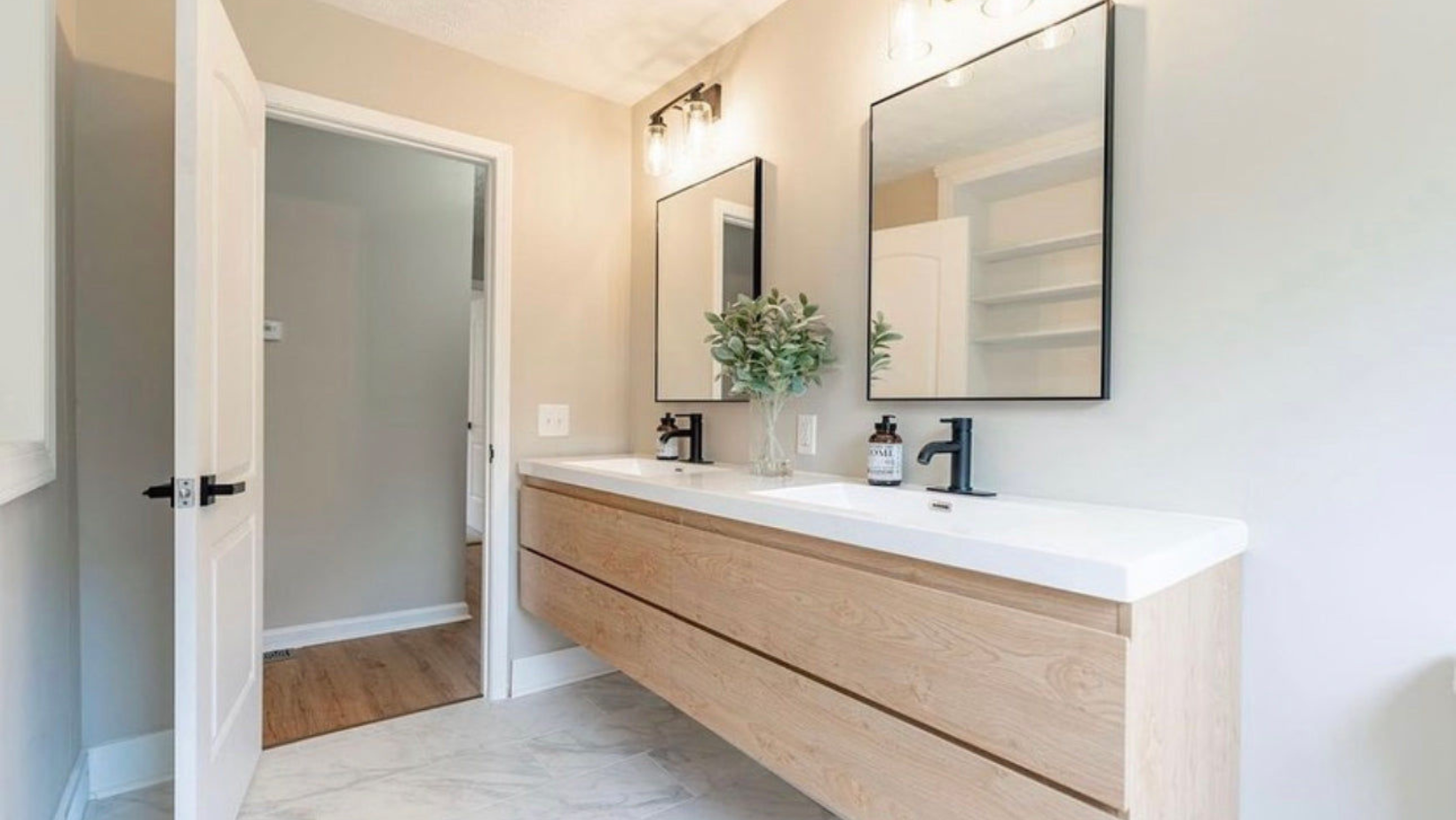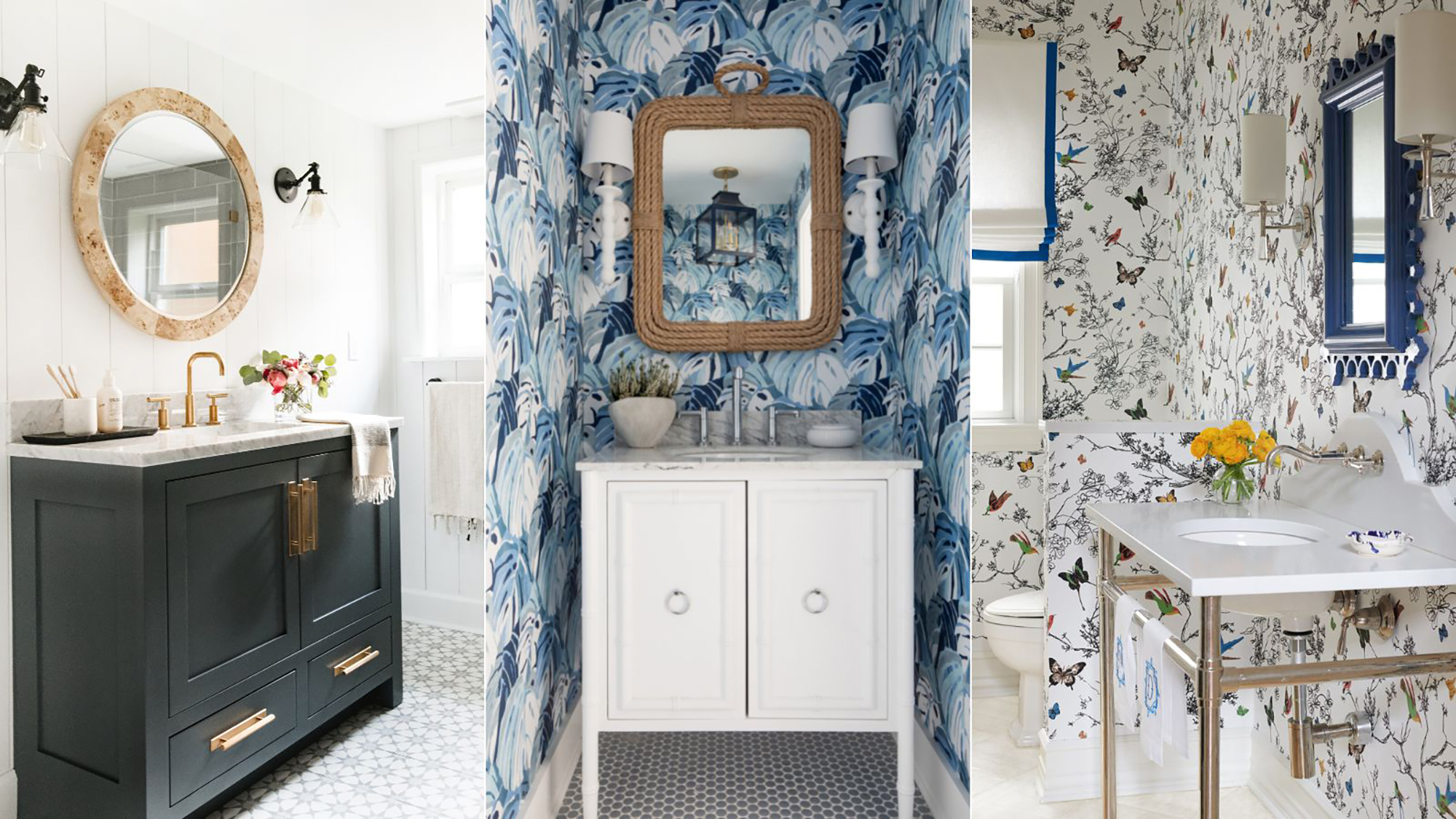Floating Vanity Design and Features
Floating vanities are a popular choice for modern bathroom design, offering a sleek and contemporary aesthetic while maximizing space. They create an illusion of openness and airiness, making even small bathrooms feel larger.
Benefits of Floating Vanities
Floating vanities provide several advantages over traditional vanities:
- Space-saving: Floating vanities eliminate the need for bulky legs or base cabinets, freeing up valuable floor space. This is particularly beneficial in smaller bathrooms where every inch counts.
- Easy Cleaning: The open space beneath the vanity allows for easy access to clean the floor, preventing dust and dirt buildup.
- Modern Aesthetic: Floating vanities offer a clean and minimalist look that complements contemporary bathroom designs.
- Visual Appeal: The floating design creates a sense of lightness and airiness, making the bathroom feel more spacious and inviting.
- Versatility: Floating vanities can be customized to suit various bathroom styles and sizes, with options for different materials, finishes, and storage solutions.
Materials Used in Floating Vanity Construction
Floating vanities are typically constructed using a variety of materials, each offering unique properties and aesthetics:
- Wood: A classic choice for floating vanities, wood offers durability, warmth, and natural beauty. Popular wood species include oak, maple, cherry, and walnut. Wood vanities can be stained or painted to match any bathroom décor.
- Laminate: A more affordable option, laminate is a durable and water-resistant material that mimics the look of wood. It is available in a wide range of colors and patterns, offering flexibility in design.
- Acrylic: Acrylic vanities are known for their sleek, modern look and high gloss finish. They are also highly durable and easy to clean.
- Metal: Metal vanities, often made from stainless steel or aluminum, offer a contemporary and industrial aesthetic. They are highly durable and resistant to rust and corrosion.
Floating Vanity Styles and Designs, Floating vanity in bathroom
Floating vanities come in a wide array of styles and designs to suit various bathroom aesthetics:
- Modern: Modern floating vanities typically feature clean lines, minimalist designs, and sleek finishes. They often incorporate materials like acrylic, metal, or high-gloss laminates.
- Traditional: Traditional floating vanities often feature ornate details, carved wood accents, and classic finishes. They may incorporate materials like solid wood, marble, or granite.
- Rustic: Rustic floating vanities often feature reclaimed wood, natural finishes, and distressed details. They often have a warm and inviting aesthetic.
- Contemporary: Contemporary floating vanities blend modern and traditional elements, creating a stylish and functional design. They may feature sleek lines, unique shapes, and a mix of materials.
Floating Vanity Features
Floating vanities typically include a range of features to enhance functionality and style:
- Storage Options: Floating vanities offer various storage options, including drawers, shelves, and cabinets, to organize bathroom essentials. Some vanities may also feature integrated medicine cabinets or open shelving for display purposes.
- Sink Types: Floating vanities can accommodate various sink types, including undermount sinks, vessel sinks, and integrated sinks. The choice of sink type often depends on the overall design aesthetic and functionality requirements.
- Countertop Materials: Floating vanities can be paired with a wide range of countertop materials, including granite, marble, quartz, laminate, and solid surface. The countertop material should complement the vanity style and provide durability and water resistance.
Pros and Cons of Floating Vanity Designs
| Feature | Pros | Cons |
|---|---|---|
| Space-saving | Maximizes floor space, ideal for smaller bathrooms. | May require more careful planning for plumbing and electrical installations. |
| Easy Cleaning | Open space beneath the vanity allows for easy floor cleaning. | Can be more difficult to access plumbing or electrical components for repairs. |
| Modern Aesthetic | Creates a sleek and contemporary look. | May not be suitable for all bathroom styles, especially traditional or rustic designs. |
| Visual Appeal | Creates a sense of lightness and airiness, making the bathroom feel larger. | May require additional lighting to compensate for the lack of a base cabinet. |
| Versatility | Can be customized to suit various bathroom styles and sizes. | May be more expensive than traditional vanities, depending on the materials and design. |
Floating Vanity Installation and Considerations

Installing a floating vanity can be a stylish and space-saving addition to your bathroom, but it requires careful planning and execution. This section explores the process, challenges, and considerations for a successful installation.
Tools and Materials
The necessary tools and materials for installing a floating vanity include:
- Stud finder
- Level
- Measuring tape
- Pencil
- Drill
- Screwdrivers
- Safety glasses
- Floating vanity unit
- Mounting brackets
- Screws
- Wall anchors (if necessary)
- Silicone sealant
- Caulk gun
Floating Vanity Trends and Inspirations: Floating Vanity In Bathroom

Floating vanities are a popular choice for modern bathrooms, offering a sleek and minimalist aesthetic. They are a testament to the ever-evolving trends in bathroom design, incorporating innovative materials and embracing the principles of functionality and space optimization.
Current Trends in Floating Vanity Design and Materials
The world of floating vanities is constantly evolving, with new trends emerging regularly. Here are some prominent trends that are shaping the contemporary bathroom landscape:
- Minimalist Design: The trend towards minimalism continues to dominate floating vanity design. This translates into clean lines, simple forms, and a focus on functionality. Minimalist vanities often feature open shelving or drawers, allowing for a streamlined and uncluttered look.
- Natural Materials: There is a growing preference for natural materials in bathroom design, and floating vanities are no exception. Wood, especially reclaimed wood, is a popular choice, bringing warmth and a touch of rustic charm to the space. Stone, such as marble or granite, is another popular option, adding a touch of luxury and sophistication.
- Integrated Sinks: Integrated sinks, seamlessly blending with the countertop, are becoming increasingly common in floating vanity designs. This creates a unified and visually appealing look, while also making cleaning easier.
- Geometric Shapes: Geometric shapes, such as circles, squares, and triangles, are being incorporated into floating vanity designs to add visual interest and a touch of modern flair. This can be seen in the shape of the vanity itself, the countertop, or the hardware.
- Smart Technology: The rise of smart technology in the bathroom has led to the integration of features like touch-sensitive faucets, built-in lighting, and wireless charging stations into floating vanities.
Impact of Modern Bathroom Design Principles on Floating Vanities
Modern bathroom design principles have a significant impact on the design and functionality of floating vanities. Some of the key principles that influence these designs include:
- Functionality: Modern bathroom design prioritizes functionality. Floating vanities, with their open storage options and often integrated sinks, are a testament to this principle. They provide ample storage space while maintaining a clean and uncluttered look.
- Space Optimization: In smaller bathrooms, floating vanities help maximize floor space, creating a sense of openness and spaciousness. They also eliminate the need for bulky cabinets, further enhancing the sense of airiness.
- Sustainability: Modern bathroom design emphasizes sustainability, and floating vanities can contribute to this goal. Many floating vanities are crafted from eco-friendly materials like reclaimed wood or bamboo, while their sleek design can reduce water usage by incorporating water-efficient fixtures.
- Aesthetics: Modern bathroom design prioritizes aesthetics, and floating vanities play a key role in achieving a contemporary and stylish look. Their sleek lines and minimalist design complement the clean and modern aesthetic of contemporary bathrooms.
Inspiring Floating Vanity Examples
Here are some inspiring examples of floating vanities from various design styles:
- Mid-Century Modern: A floating vanity with a walnut countertop, tapered legs, and brass hardware would be a perfect fit for a mid-century modern bathroom. The warm wood tones and clean lines of the vanity would complement the retro-inspired aesthetic of the space.
- Industrial Chic: A floating vanity with a reclaimed wood countertop, exposed metal piping, and industrial-style lighting would create a cool and edgy vibe in an industrial-chic bathroom. The raw and unfinished elements of the vanity would complement the exposed brick walls and vintage metal accents of the space.
- Scandinavian Minimalism: A floating vanity with a white countertop, simple drawers, and minimal hardware would be ideal for a Scandinavian minimalist bathroom. The clean lines and light colors of the vanity would complement the minimalist aesthetic of the space, creating a sense of calm and serenity.
- Coastal Contemporary: A floating vanity with a light-colored wood countertop, open shelving, and coastal-inspired accessories would create a relaxed and inviting atmosphere in a coastal contemporary bathroom. The natural elements of the vanity would complement the blue and white color scheme of the space, evoking a sense of the ocean and the beach.
- Traditional Elegance: A floating vanity with a marble countertop, intricate carvings, and ornate hardware would add a touch of elegance and sophistication to a traditional bathroom. The rich textures and details of the vanity would complement the classic elements of the space, creating a timeless and luxurious feel.
Tips for Incorporating Floating Vanities into Different Bathroom Aesthetics
Here are some tips for incorporating floating vanities into different bathroom aesthetics:
- Consider the Overall Style: Choose a floating vanity that complements the overall style of your bathroom. If you have a modern bathroom, opt for a sleek and minimalist vanity. If you have a traditional bathroom, choose a vanity with more ornate details.
- Match the Materials: Select a floating vanity that matches the materials used in the rest of your bathroom. If you have a lot of wood in your bathroom, choose a vanity with a wood countertop. If you have a lot of stone, choose a vanity with a stone countertop.
- Think About the Size: Choose a floating vanity that is the right size for your bathroom. If you have a small bathroom, choose a compact vanity. If you have a large bathroom, choose a larger vanity with ample storage space.
- Accessorize Accordingly: Use accessories to enhance the look of your floating vanity. You can add a decorative mirror, stylish lighting, or beautiful plants to create a more personalized and inviting atmosphere.
